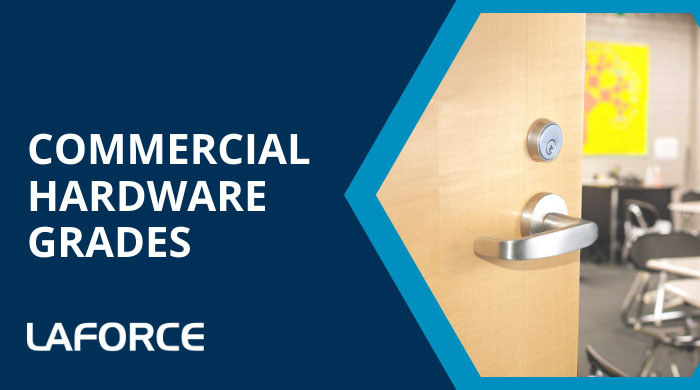Hardware grades are an important tool for determining the appropriate hardware for a door opening. The grades are developed by the American National Standards Institute (ANSI) and the Builders Hardware Manufacturers Association (BHMA). ANSI and BHMA set the requirements for the laboratory testing of door hardware. They also established three different grades or classes of hardware. Each grade has a set of minimum performance standards, with one of the most important standards being the number of cycles or uses the product can withstand during its lifetime, known as cycle count. How well a piece of hardware performs under laboratory testing determines its hardware grade.
The regulations cover a wide range of hardware products from locks to hinges to door closers, each with its own performance standards and testing criteria. For example, the minimum number of required cycles for Grade 1 butt hinges is different than the minimum number of required cycles for Grade 1 exit devices. The hardware grade helps building owners, contractors, and architects determine the durability of the product, its expected lifecycle, and the environment in which it should be used. Knowing and using the correct hardware grade for your opening can also help save you money by minimizing replacement and maintenance costs.
Grade 1 Hardware: Heavy-Duty Commercial
- Commercial facilities
- Designed for heavy use in high-traffic buildings (commercial entrances, exterior doors)
- Highest number of cycles/uses
- Most secure and vandalism-resistant type of hardware
- Higher cost
Grade 1 hardware is designated for use in commercial facilities. It is built to function properly even with heavy use in high-traffic buildings and withstand the highest number of cycles/uses. Since it is designed to be durable, Grade 1 hardware is also the most secure and vandalism-resistant type of hardware. However, in order for the hardware to be as durable and secure as possible, it must be properly installed onto a door that is functional and up to code. Because Grade 1 hardware is considered top-of-the-line, it does come with a higher price tag; but if your building has commercial openings that are being used frequently (ex. commercial entrances, exterior doors, etc.), it pays to invest in heavy-duty Grade 1 hardware.
Grade 2 Hardware: Light-Duty Commercial
- Light-duty commercial buildings
- Lighter traffic flow (small businesses, private offices)
- Cycle/use requirement is less than Grade 1 hardware, but more than Grade 3
- Costs less than Grade 1, but more than Grade 3
Hardware labeled Grade 2 is designed for light-duty commercial usage. This type of hardware is a secure choice for openings with a lighter traffic flow. Grade 2 hardware is commonly found in buildings with fewer daily users such as small businesses or offices with few employees since its minimum cycle/use requirement is less than Grade 1 hardware. Hardware labeled Grade 2 can also be used on doors that are not used regularly in higher traffic buildings, like private offices or storage closets. Although this hardware grade generally costs less upfront, using Grade 2 hardware when Grade 1 is needed will end up costing you more money in maintenance, repairs, and replacements.
Grade 3 Hardware: Residential
- Residential use
- Least amount of traffic (residential houses)
- Cycle count is much lower than Grade 1 or 2
- Least durable and secure
- Least expensive
Grade 3 hardware is the least expensive of the three types, but it is also considered the least durable and the least secure, which is why it is only recommended for residential use. Locks labeled Grade 3 are more easily bypassed than Grade 1 or 2 locks and the minimum cycle count is much lower. However, the average door in a home gets much less traffic than a commercial door, making Grade 3 hardware a suitable choice. Grade 3 hardware should not be installed in commercial buildings; doing so would compromise the security of the building and lead to more time and money spent on replacements and maintenance.
Hardware Grade Testing
For a product to be BHMA/ANSI certified for a specific grade, hardware manufacturers must submit their product to an independent testing agency. If the product meets the minimum requirements for all tests within the BHMA/ANSI standard, it is certified for the tested grade level. To make sure certified products continue to comply with the tested standards, hardware items are periodically retested and sometimes the manufacturing facility is randomly audited. Learn more about ANSI/BHMA standards on their website.
Different hardware products that meet the same grade may not be truly equal. Since hardware grades are based on passing the minimum requirements of the ANSI/BHMA standards, the exact test results can vary by manufacturer and product. For example, the cycle count test results might be higher for one lock compared to another, but because they both meet the minimum cycle count, they both qualify for the same hardware grade. It’s important to consult the manufacturer or a hardware specialist to determine which product you should use in your building since they are the experts in their particular products.
LaForce partners with the top vendors to provide commercial door hardware that is code compliant, functional, and aesthetically pleasing. Our experts can help you decide on the best hardware to fit the needs of your building. Check out our linecard to see our comprehensive list of hardware options and contact us today to get started!



Follow Us